Planting of new Camellias at Mount Edgcumbe has been somewhat sporadic in recent years but there has been enough to ensure that every year there are things flowering for the first time. This year has been slightly different in that there are a few things flowering, or at least in bud, that are far from being recent plantings; rather, they are flowering for the first time many years after they were planted.
One such is a bush on the Earls Drive, labelled C. japonica ‘Fanny’. There is, or was, as C. japonica variety called ‘Fanny’, or ‘Fanni’, but this was obviously a sasanqua and I have held off relabelling it only because until this year it has never flowered. The collection records show it to have been planted in 2005. It is in shade under a high tree canopy, so getting good light but little or no direct sunlight. Nothing has changed but this year it had buds and they have opened to small, formal double, light pink flowers. It is a good match for the photographs in the Camellia Register, less so the text description of “vivid pink to carmine”. I am reassured that it is in fact C. sasanqua ‘Fanny’.
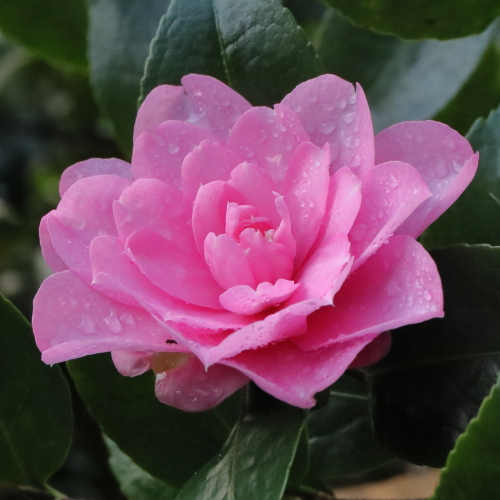
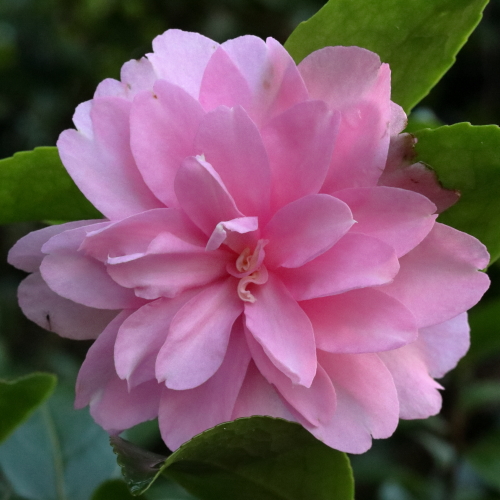
Also making a first appearance this year is C. sasanqua ‘Paradise Little Liane’. This is planted under a quite dense and low tree canopy and while I am very sceptical about it having been planted in 1975, as the records say, it has certainly been there a long time, perhaps twenty years or so, and has never produced so much as a bud, to my knowledge. This year, again with no obvious change in its growing conditions, it has produced a few flowers. It wasn’t a dazzling display but even so my pictures sell it short. Taking pictures on a very dull day in late November, in shade, has produced a blue shade that I’m struggling to correct.
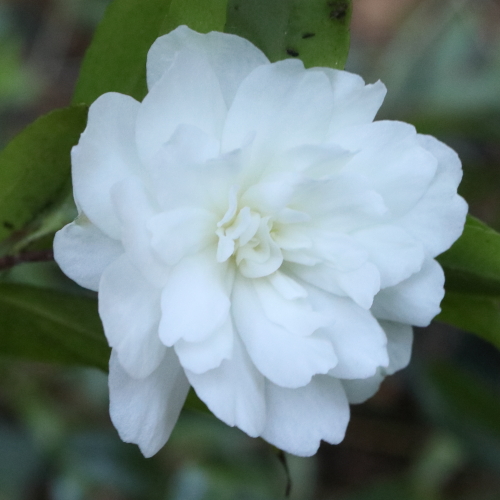
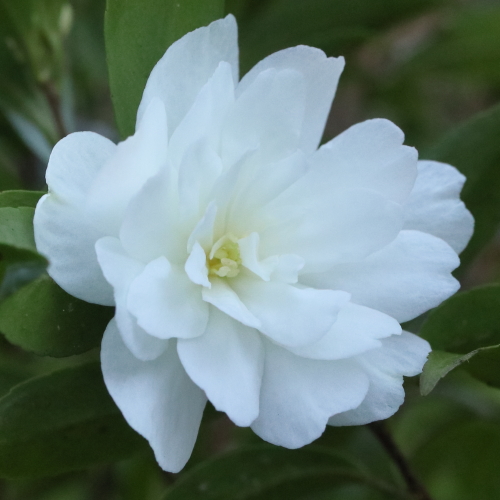
‘Paradise Little Liane’ is a variety I am very familiar with, in that I have a plant in my garden. It is at the front of the house, with a white painted south facing wall behind it. It gets sun most of the day, if there is any. It flowers well every year and this year is exceptional. On the face of it, it needs a sunny position to flower well.
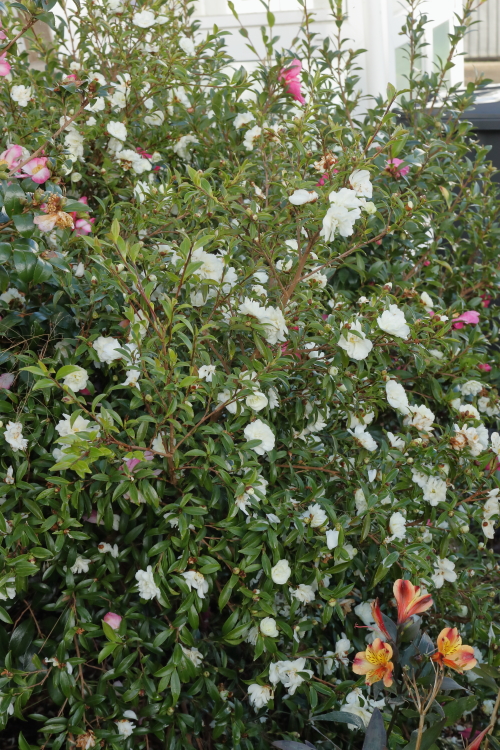
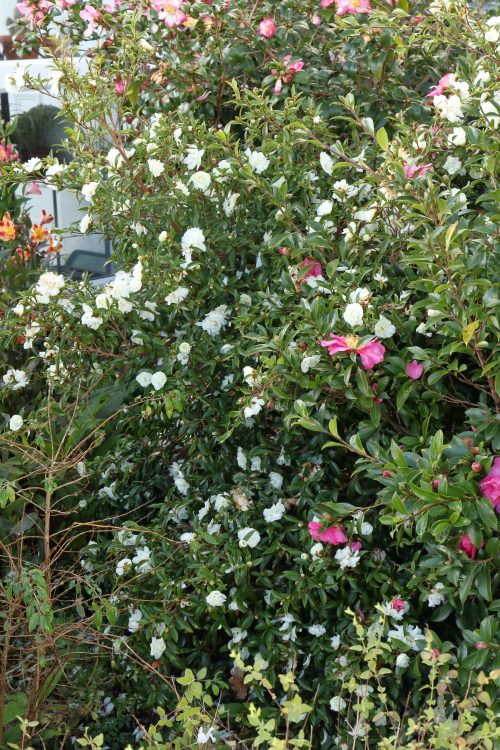
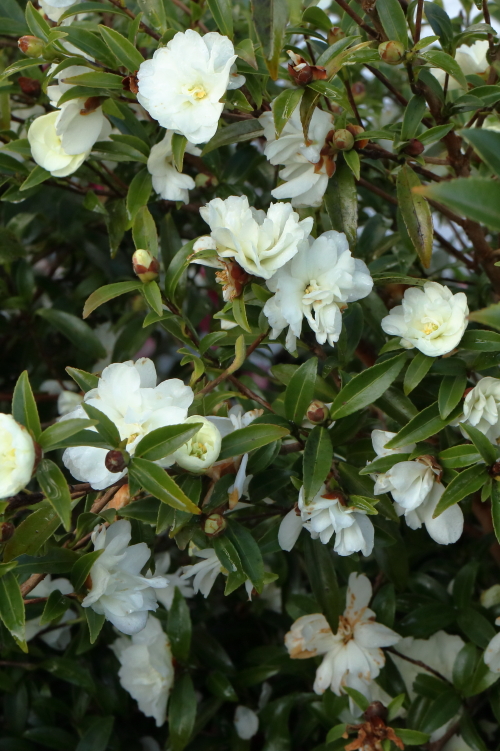
Jennifer Trehane* says that sasanquas do best where they get an early, frost free start to spring, such that they can make 10-12 weeks of shoot growth and then have time for the growth to mature and flower buds to be initiated. Flower bud initiation takes place when there are long days and relatively high temperatures, usually July-August in the northern hemisphere. Flower opening then requires short days and considerably lower temperatures, especially night temperatures. The difference in flowering times of different cultivars is due to their differing responses to these conditions.
I would be inclined to add in a need for adequate moisture in the growth and bud initiation period and I am left wondering whether a plant growing in shade registers a shorter day length than one growing in the open, and what the significance of that might be.
It seems straightforward to attribute the flowering of these two plants to the exceptionally hot weather we had in June, but I’m reluctant to rush to judgement. It’s complicated, and very few of us have experience of growing a particular cultivar in a range of different conditions; I would caution against jumping to conclusions about the merits of any variety on the strength of seeing how only one plant performs. Even when, as with ‘Little Liane’, two plants in different conditions perform very differently, it need not necessarily be simply the obvious difference, e.g. sun/shade, that accounts for all the difference in performance. Water, nutrition, temperature and so on will also differ and are not so easy to see.
* Jennifer Trehane, Camellias, the Garden Encyclopaedia, Timber Press, 2007.
David Parks told me he believes from discussions and visiting with the Japanese and observation in USA that Sasanquas set flower buds (almost invisibly) in May/June– and June in Kyushu island, the main original habitat for Sasanquas in their native Japan is their rainy month having the highest rainfall in the year, so I find that interesting.
My C. sasanqua ‘Fanny’ was in flower on purchase in 2017, but has not set flower buds since, so I attribute that to its peculiar temperament or constitution! It is in overhead sun and kept watered.
In my experience over the last 25+ years of growing them, some just are more fussy and need to get their roots deeper down or become well-established. Fortunately the Sasanquas behaving like that are the exception! My ‘Hugh Evans’, which everyone thinks is a model plant, is now performing at the level to be expected of an AGM plant; but since 2006 until 2021 it was wholly unreliable and often did not flower, despite watering and the advantage of being in full-sun. Cleopatra (syn New Dawn) has taken at least 5 years to flower and I have 5 different plants of it at the moment, all planted in different places, four in full sun, and all of different provenance. I now wait for the fifth plant to get to flowering age, although it is approximately 5 feet or 150cms tall.
My plant purchased as ‘Fuji-no-mine’ (from Trehane’s) on the other hand sets huge numbers of buds but most years they all drop off during what would be its flowering season, as has happened this year despite assiduous watering from June until October. This is a weakness I think in this particular variety that it is overly water-sensitive and I shall try digging it up next year to check its roots, but I note that Trehane’s are not surprised by this problem. It has flowered well about twice in 18 years! Another one like it is Hinode-fuji ( syn. Hime-botan). I was relieved to see it flowering in Italy on Lake Orta at Villa Motta this year and to know it is possible for it to keep its buds and not drop them at flowering time.
LikeLike
That is interesting about the flower bud initiation. I suppose it is stating the obvious that the buds would be initiated well before they are apparent on the plant but that is a long time before. It rather suggests that this year’s hot June was responsible for a good bud set generally and for flower buds on varieties that had not flowered before, at least at Mt. Edgcumbe. There would still have been moisture in the ground then too.
As far as I can recall the Mt. E. plant of ‘Mine-no-yuki’ has been pretty reliable over the years I’ve known it, but the plant labelled ‘Sasa-no-yuki’, which I am pretty certain is the same, produced almost no buds at all until a tree near it fell and it had more light, and those it did have shrivelled and never opened. For the last two years it has produced a few more buds and they’ve all opened.
‘Mine-no-yuki’ is at the foot of a hill, so never short of moisture even though it’s in full sun. ‘Sasa-no-yuki’ still doesn’t get much direct sun but is in poor dry soil.
When you have several factors intertwining to affect flowering, and having that affect many months before flowering actually occurs, it gets very difficult to join the dots and work out what is ideal for each cultivar. Even then, the weather is beyond control and once a decision is made about where a plant is going, you can’t keep moving it around.
LikeLike
Dear Jim,
Indeed, this is undoubtedly C. sasanqua ‘Fanny (sasanqua)’ from Thoby. Please note that this plant was obtaiend by Claude Thoby as a seedling from Mr Jones (Savannah, USA) in 1978 and later named ‘Fanny’ by Claude Thoby.
It should have an open to almost spreading habit. I’m not suprised that it doesn’t flower much in the shade, it’s the same here : it needs to be in full sun to flower nicely, and it will never be the most profuse bloomer among sasanquas.
Regards,
Pascal Vieu
LikeLiked by 1 person
That is slightly at odds with the Register then, in that they say it “Originated in France”. I suppose if Thoby obtained it as an un-named seedling then it originated in France as a named cultivar. Not that it really matters. Your description of its habit fits, it’s just a little wider than high, with mostly horizontal branching. It would be good to get another plant of it going in more suitable conditions; it’s an attractive variety.
LikeLike
Well, actually it’s quite usual: there are many cultivars “from the USA” that came as seeds collected in Japanese gardens (and sometimes cuttings without a name, such as ‘Maiden’s Blush’).
As an example, in 1979 Thoby and Jean Laborey were sent seedlings that had been discarded from the Clifford Parks “black camellia” selection programme, then Thoby made his own selection and named some of them (Dr Ecorchard, Paul Plantiveau, Jean Renaud, etc.).
They have never been officially registered by submitting a form with detailed information, as we do now, but they came into the Register when Tom Savige compiled the major nursery catalogues to create the first Register, especially Thoby’s 1993 catalogue with pictures and descriptions.
LikeLike